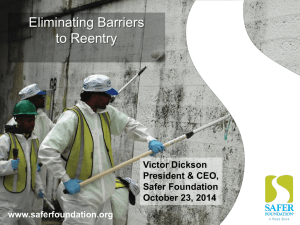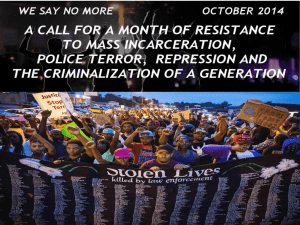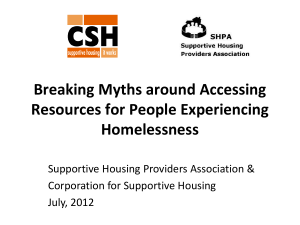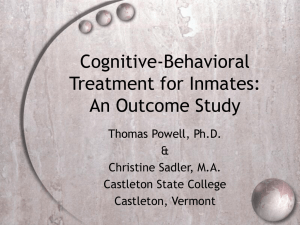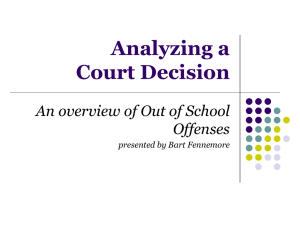Using the Drug Court Model to Provide Residential
advertisement
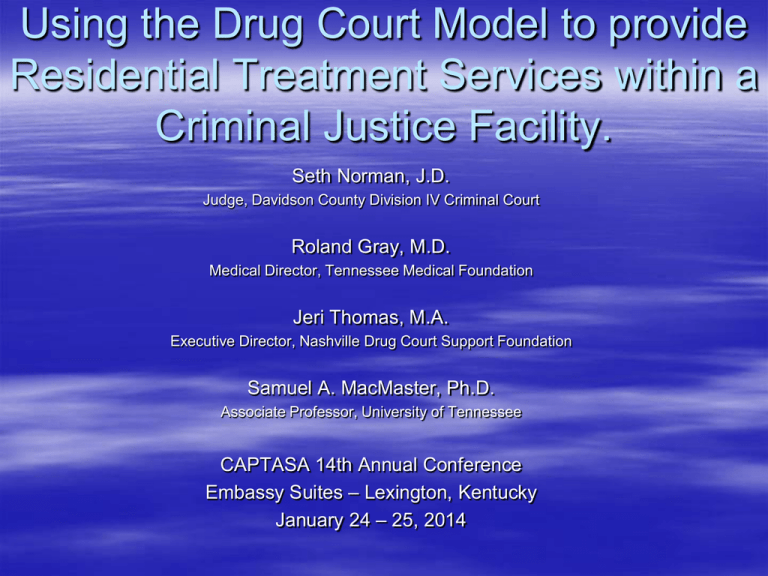
Using the Drug Court Model to provide Residential Treatment Services within a Criminal Justice Facility. Seth Norman, J.D. Judge, Davidson County Division IV Criminal Court Roland Gray, M.D. Medical Director, Tennessee Medical Foundation Jeri Thomas, M.A. Executive Director, Nashville Drug Court Support Foundation Samuel A. MacMaster, Ph.D. Associate Professor, University of Tennessee CAPTASA 14th Annual Conference Embassy Suites – Lexington, Kentucky January 24 – 25, 2014 Incarceration There are currently more than 2.2 million incarcerated individuals in the United States, almost all of whom will return to the community (BJS, 2011). An estimated eighty percent of incarcerated individuals have serious substance abuse problems (CDC, 2001). Individuals charged specifically with drug offenses constitute the majority of federal prisoners (51%), and a significant proportion of state prisoners nationwide (18%) (Guerino, Harrison and Sabol, 2011). Additionally, significant proportions of state prisoners (19%) and federal inmates (16%) reported committing their current offense to obtain money for drugs (Mumola and Karberg, 2006). Recidivism Unfortunately despite incarceration, most individuals who are released to the community return to prison within a short period of time. While recidivism rates vary widely by state, within three years, almost half (43.3% to 45.4%) of all prisoners nationwide return to prison (Pew Center on the States, 2011). Recidivism rates in the state of Tennessee are even higher. Three-year recidivism rates in Tennessee are 46.1%, and four-year rates are 54.8% (TDOC, 2010). Cost of Incarceration The financial cost of incarceration is significant, particularly for state governments. Nationwide, the estimated cost of a year of state incarceration is $26,000 per person (Schmitt, Warner, and Gupta, 2010). Last year, alone, states collectively spent over fifty-one billion dollars on corrections (NASBO, 2011). The Drug Court Model Due to the poor outcomes and the high cost of incarceration, the Drug Court Model was developed as a more effective alternative. Typically, drug courts work with the court system, community corrections, and community-based substance abuse treatment providers to provide sustained monitoring and consequences for relapse to ensure that individuals engage in, and benefit from, community-based substance abuse treatment. Overview of the Nashville Innovation By utilizing this model and applying it to a residential setting, the Davidson County Drug Court Residential Program (DC4) was developed as a two-year program targeted to substance dependent felons who are not eligible for community release. Brief History Established in 1996 Originally had capacity to house seven men Added Women’s component in 1997 Current facility was built in 2000 Added Methamphetamine Program in 2005 Added Mental Health Component in 2008 THE ORIGINAL FACILITY THE BUILDING WE STARTED IN HAD ROOM FOR EIGHT MALES WHERE WE ARE NOW A LONG TERM RESIDENTIAL FACILITY THAT ACCOMODATES 40 FEMALES AND 70 MALES THE FRONT ENTRANCE FRONT RECEPTION AREA RESIDENCE HALL FOR WOMEN THE FEMALE RESIDENCE HALL RESIDENCE HALL FOR MEN CLASS ROOM KITCHEN THE RESIDENTS PREPARE AND SERVE ALL MEALS THE OLD COURTROOM THE NEW COURTROOM CONSTRUCTED BY RESIDENTS ONE OF THE TWO RESIDENCE HALLS ADDED FOR THE METH PILOT PROJECT DC-4 GRADUATES LINE THE HALL TO WELCOME A VISITOR ATTORNEY GENERAL, DRUG CZAR AND SECRETARY OF HEALTH VISIT DRUG COURT THE SOFTBALL FIELD CONSTRUCTED ENTIRELY BY THE RESIDENTS RESIDENTS REHAB AN OLD ANIMAL SHELTER BUILDING TO BE USED FOR VOCATIONAL TRAINING EQUIPMENT ROOM THE WOOD WORKING SHOP EQUIPMENT SHED FARMING EQUIPMENT THIS WAS SURPLUS PROPERTY RESIDENTS WORKING THE GARDENS ANOTHER GARDEN PLOT MORE FARM EQUIPMENT WE OBTAIN MOST OF OUR FARM EQUIPMENT FROM STATE SURPLUS RESIDENTS WHO VOLUNTEERED TO DO PUBLIC SERVICE HELPING FLOOD VICTIMS RESIDENTS DOING PUBLIC SERVICE WORK IN FLOOD AREAS Roland W. Gray, M.D., FAAP, FASAM Repeat criminal offenders Significant history substance abuse Unemployed Dual diagnosis Prior Treatment failure Treatment In house 12 Step Philosophy Group Individual DBT CBT RET Support Services Substance Abuse Mental Health Physical Health Four Phases Individualized Behavioral relapse Chemical relapse Phase I Assessment Orientation Support Services Four weeks to three months Phase II Stabilization and Rehabilitation Recovery Support Community Steps I-V AA Relapse Prevention Plan Three to six months Phase III Transition to community Obtain employment 300 hours community service 450 hours employment Sober living facility Three to six months Community Service Moral character – Self esteem Landscaping schools 60,000 hours On-Site Vocational Training Assessment Résumé assistance Interview skills Vocation (cont.) Small mechanics Garden Painting Automotive body shop Upholstery Woodshop Culinary Phase IV Aftercare DC-4; 4/week UDS Twice a week Probation officers Monitor housing employment Nine to twelve months Sustained monitoring Consequences Samuel MacMaster, Ph.D Program Results Data was available for nearly seventeen hundred individuals (1,684) who entered treatment during a fifteenyear period of time between April of 1996 and November of 2013. All participants had received residential services; average length of stay was 482 days (s.d.=323). At the time of program entry, participants’ average age was 33.1 years, (s.d.=9.1), nearly two-thirds, (62.4%), were under the age of thirty-five, and nearly a quarter, (24.2%), were under the age of twenty-five. The majority of participants were male (74.8%) and Caucasian (50.5%). Criminal Backgrounds Participants are reflective of the program’s focus on the needs of hard to reach, repeat criminal offenders who have long-term histories of criminal justice involvement and chronic substance use problems. The average number of lifetime arrests is more than twelve (12.7), and on average the number of arrests in the last two years is more than four (4.1). Drug offenses made up the majority (58.0%) of the offenses that brought individuals to the program; followed by other drug-related offenses of theft (13.0%) burglary (7.7%) and aggravated burglary (7.1%). Participants had been sentenced to serve an average of 2,364 days, or approximately six and a half years. Substance Use Backgrounds On average, participants had used substances for 18.4 years. The majority of participants (62.1%) had received substance abuse treatment in the past, but none had been able to initiate or maintain their recovery. Participants were most likely to identify their current drug of choice as cocaine (50.6%) followed by marijuana (13.2%), methamphetamines (12.6%), prescription pain pills (10.0%), and alcohol (8.2%). First average reported drug use was 14.7 years, and the majority of participants (53.1%) had used prior to age fourteen. Social Functioning Backgrounds None of the participants were employed, and more than a third (37.4%) had never held the same job for a year. Only a quarter (27.6%) currently had a valid drivers license. As a group, participants averaged 11.3 years of formal education. Nearly two-thirds (61.9%) had not graduated from high school. Less than a third (32.1%) lived in their own home or apartment at the time of their arrest. In terms of marital status, nearly two-thirds (62.8%) had never been married and few (12.7%) were currently married. More than a third of participants (36.3%) reported that they had a mental illness, and only 14.0% had received any mental health treatment in the past year. Results: Recidivism In terms of arrests and convictions after completing and graduating from the two-year program, the majority of individuals who completed the program (61.7%) were not rearrested and convicted for any new offenses. More than two-thirds of program completers (76.7%) were not rearrested and convicted for new violent or drug offenses. Almost all program completers (94.8%) were not rearrested and convicted for new violent offenses. More than three-fourths (81.9%) were not rearrested and convicted for new drug-related offenses. Results: Substance Use and Employment All program participants were employed full-time at the time of graduation and had maintained that employment for approximately a year. This is a significant increase from the time of program entry, during which no one was employed. As a requirement of graduation, all program participants must be completely abstinent for one-year. Substance use is also monitored by regular urine drug screens, which were negative at a rate greater than 99%. Cost Savings Savings on incarceration were calculated comparing the costs of DC4 versus continued incarceration in jail or prison. These calculations do not account for any of the other potential financial benefits the community may have incurred due to the program, i.e. the number of individuals working and paying taxes, the number of individuals regaining custody or making financial contributions for their children, or the potential cost savings for individuals who are no longer engaged with the criminal justice system. Calculations for Cost Savings Costs savings were calculated using three different comparisons: – the savings compared to the cost of incarcerating individuals for their complete sentence, – the savings compared to the cost of incarcerating individuals for half of their sentence, and – the daily cost savings based on housing individuals in DC4 only for the days they were residents. A day of services at DC4 has been calculated to cost $48/day by an outside auditor (Farmer, 2006). The cost of state incarceration is reported to be $65/day by the Tennessee Department of Corrections (TDOC, 2011). Savings vs. Complete Sentence The average length of the sentence for a DC4 resident was 2,364 days. Assuming that each individual served their entire sentence, the total cost to the community would be $153,660 on average to incarcerate each individual. The average length of time in the DC4 program was shorter, at 482 days, with a total cost of $23,136. Assuming that each individual completed their sentence, the community experienced a cost savings of $130,524 per person, for the 1,296 individuals who have completed the residential portions of the program, i.e. phases one through three. Cost savings are $169,159,104 Savings vs. Half Sentence The assumption that individuals serve their entire sentence behind bars does not necessarily reflect reality, as individuals often receive reduced sentences for a reward for good behavior. Even assuming that each individual would have only served half of their sentence, 1,182 days as opposed to 2,364 days, the community would still realize significant cost savings. Incarceration costs would be calculated to be $76,830 per person, saving the community $53,694 per person or a total of $69,587,424. Savings on daily rate At a minimum, the community saved significant amounts of money simply by placing individuals in the DC4 program as an alternative to a county or state facility. For the 1,296 individuals who have completed the residential portions of the program a total of 624,672 days have been served at DC4. This is clearly an underestimate of the total savings cost, as the significant cost savings for individuals still participating, or who dropped out before completing, are not included in this calculation. For these individuals alone, the community has saved a total of $10,619,424. Jeri Thomas, M.S.
